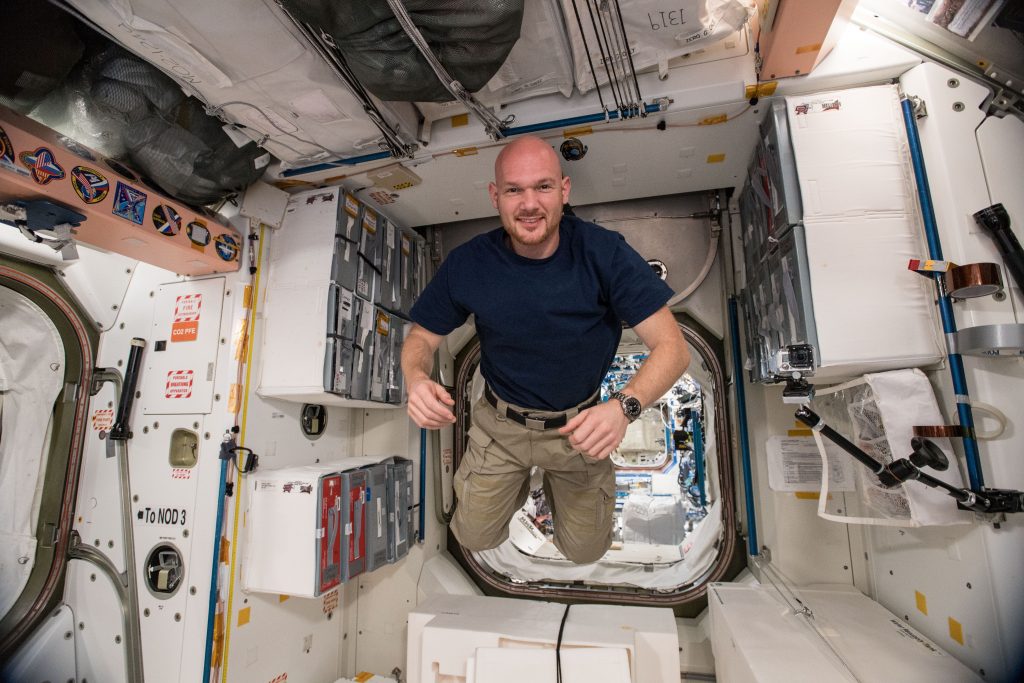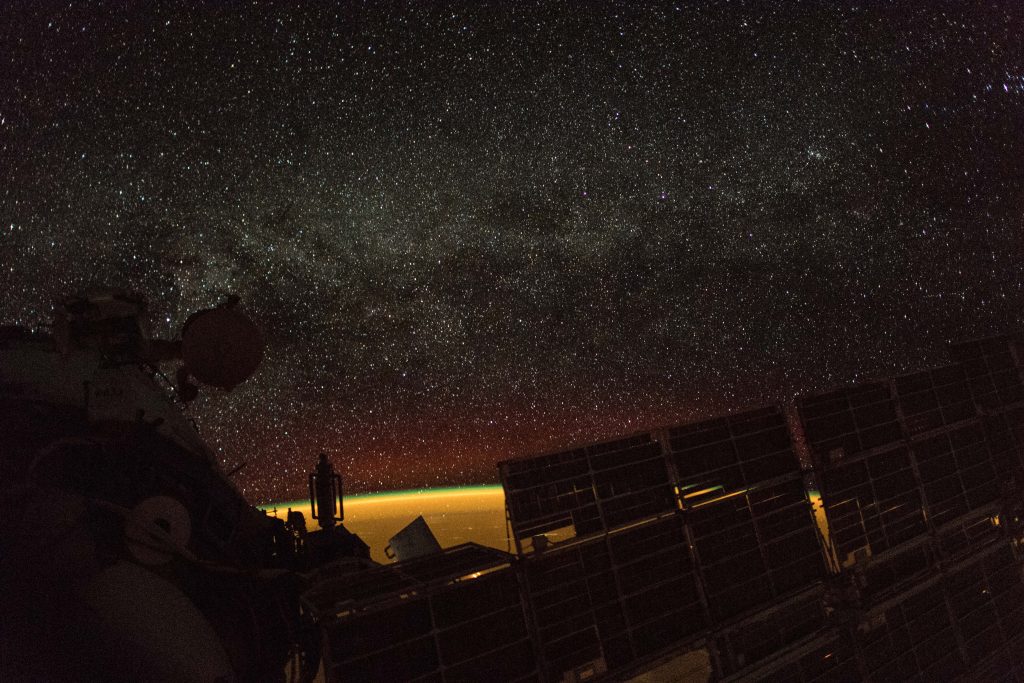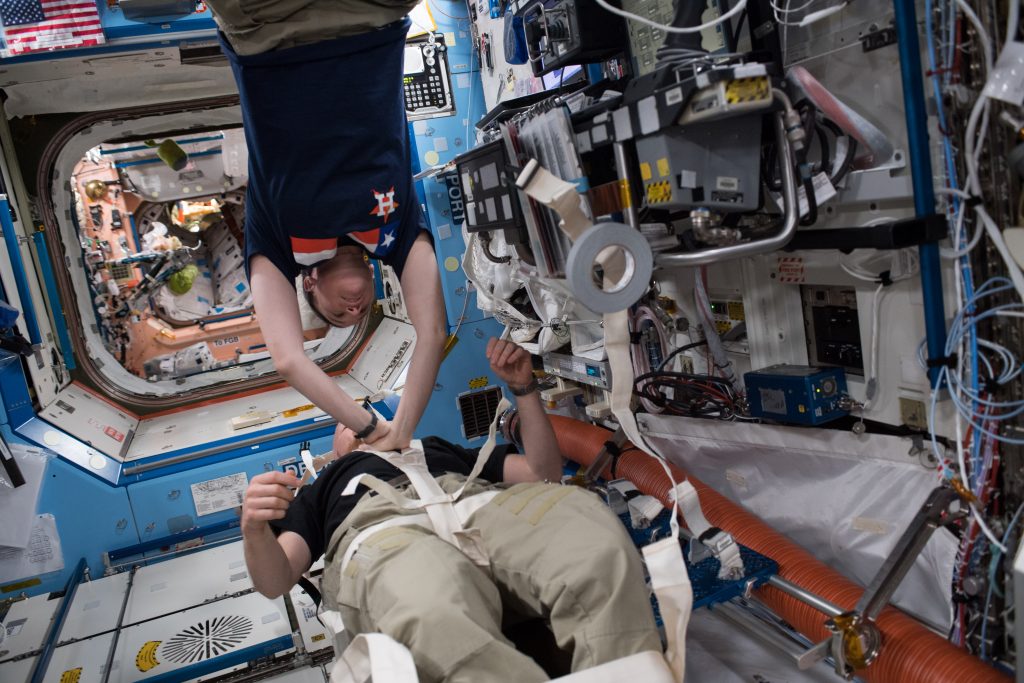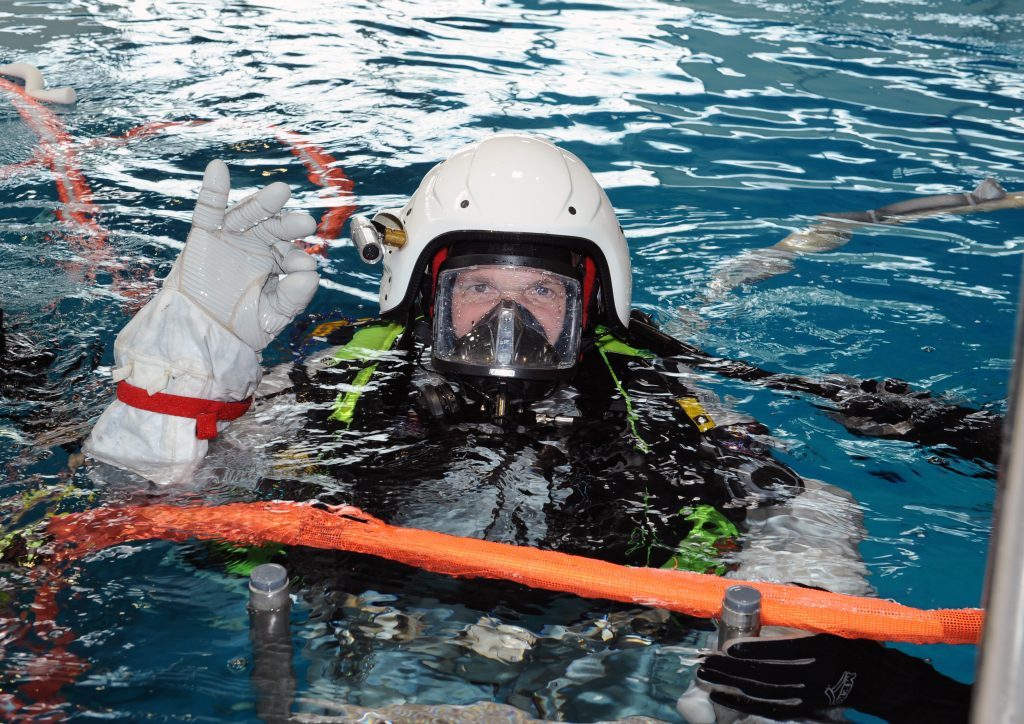Vor 20 Jahren, am 20.11.1998, wurde das erste Modul der Internationalen Raumstation Zarya in den Weltraum gesandt. Das nehmen wir zum Anlass, um die 20 am häufigsten gestellten Fragen zu Alexander Gersts Mission an Bord der Raumstation zu beantworten.
1. Wie lange dauert die Reise zur Internationalen Raumstation?
Die Reise vom Startplatz in Baikonur in Kasachstan bis zur Internationalen Raumstation kann je nach Startverfahren und Position der Station im Orbit zwischen 6 und 48 Stunden in Anspruch nehmen.
Am 6 Juni 2018 startete ESA-Astronaut Alexander Gerst um 11:12 Uhr GMT (13:12 Uhr MESZ) zusammen mit NASA-Astronautin Serena Auñón-Kanzler und Roskosmos-Kommandanten Sergei Prokopyev an Bord der Raumsonde Sojus MS-09 ins All. Nach insgesamt 2 Tagen und 34 Erdumkreisungen kam das Trio wie geplant am 8. Juni um 13:01 GMT (15:01 MESZ) sicher auf der Internationalen Raumstation an.
Hier können Sie sich den Start vom Liftoff bis in den Orbit ansehen:
2. In welcher Höhe und mit welcher Geschwindigkeit ist die ISS unterwegs?
Die Internationale Raumstation umkreist die Erde alle 90 Minuten einmal. Sie bewegt sich dabei mit einer Geschwindigkeit von rund 28 800 km/h und in einer Höhe von 400 km.
3. Kann ich die Internationale Raumstation von der Erde aus sehen? Und wenn ja, wie?
Ja! Viele von Ihnen haben das auch schon getan. Die Internationale Raumstation sieht als dritthellstes Objekt am Himmel wie ein Flugzeug aus- nur eben viel höher und viel, viel, viel schneller.
Die NASA-Webseite Spot The Station liefert die wichtigsten Informationen darüber, wann die Internationale Raumstation in Ihrer lokalen Zeitzone zu sehen ist. Unter anderem erhalten Sie hier Angaben über die maximale Zeitspanne, in der die Station sichtbar sein wird, ihre Höhe am Horizont am Nachthimmel, die Position am Himmel, an der sie zuerst sichtbar sein wird und den Punkt, an dem sie verschwinden wird.
Allerdings lässt sich die Position der ISS mit Apps wie ISS Spotter (hier) oder dem Tracker auf der ESA-Website unkomplizierter bestimmen.
4. Gibt es Schwerelosigkeit auf der ISS?
Die kurze Antwort: nein. Die Schwerkraft, oder besser gesagt die Mikrogravitation, ist überall im Weltraum. Sie hält den Mond im Orbit um die Erde und die Erde im Orbit um die Sonne. Aber warum fällt dann die Raumstation nicht auf die Erde zurück und warum scheint es so, als ob Astronauten im Weltraum schweben? Das hat alles mit Geschwindigkeit zu tun.
In Wahrheit schweben Astronauten nicht, sie „fallen“. Aber wegen der hohen Geschwindigkeit der Umlaufbahn der Station fallen sie um die Erde und nicht darauf. Die Internationale Raumstation fliegt in einer Geschwindigkeit von etwa 28.800 km/h, aber während sie unter dem Einfluss der Schwerkraft zur Erde gezogen wird, bewegt sich die Erde unter ihr weg. So kommt ihr die ISS nie näher. Da Astronauten die gleiche Beschleunigung wie die Raumstation haben, erscheinen und fühlen sie sich „schwerelos“.
5. Wie fühlt es sich an auf der ISS zu schweben?
In seinem ersten Blogbeitrag der Horizons Mission berichtete Alexander Gerst davon, wie er die Schwerelosigkeit auf der ISS empfand: „Als sich die Luke zur Raumstation öffnete, fühlte es sich an, als würde ich nach Hause kommen. Ich kam auch sofort mit dem Schweben zurecht, genau wie ein Fisch mit Wasser. Interessanterweise haben sich meine Füße und Hände sogar unbewusst daran erinnert, wo sich Handläufe und Fußschlaufen befinden, und normalerweise haben sie den richtigen Handlauf von selbst ergriffen. Aber an einem Tag ist es nicht so gut gelaufen. Mein Körper dachte, er wüsste genau, wo ein Griff sein musste und ich streckte die Hand aus, um ihn zu greifen – nur um festzustellen, dass ihn jemand seit meiner letzten Mission bewegt hatte….“
In diesem früheren Interview zur Blue Dot-Mission sagte Alexander Gerst, dass es sich an Bord der Raumstation am Anfang so ähnlich anfühle, als ob man von einem 10 Meter hohen Sprungbrett springe und man wie eine Fledermaus von der Decke hängen würde. Er erlebte in den ersten zwei Stunden ein Kribbeln in seinem Magen. Schlecht wurde ihm aber davon nicht.
Nach zwei Tagen passte sich sein Körper so an, dass ihm alles normal erschien.

ESA-Astronaut Alexander Gerst an Bord der Internationalen Raumstation. Credit: ESA/NASA.
6. Wie warm bzw. kalt ist es in der ISS? Wie hoch ist die Raumtemperatur?
Die Temperatur innerhalb der Internationalen Raumstation wird konstant auf etwa 22°C gehalten.
7. Nach welcher Zeitzone richtet sich die Crew der ISS?
Die Internationale Raumstation verwendet UTC oder Universal Coordinated Time. Diese wird auch als GMT oder Greenwich Mean Time bezeichnet und liegt eine Stunde hinter der MEZ (Central European Time).
UTC wurde als Zeitzone für die Station gewählt, da sie sich in der Mitte der Partner der Internationalen Raumstation befindet und somit den beiden Hauptmissionskontrollzentren (Moskau und Houston) ermöglicht, jeweils eine halbe Tagesschicht abzudecken.
8. Welche Uhr tragen Astronauten?
ESA-Astronauten tragen eine Omega Speedmaster X33 Skywalker – eine neue Version der historischen Weltraumuhr, die mit Hilfe der ESA für einen Flug ins All getestet und qualifiziert wurde.
Das Design dieser Uhr basiert auf den Erfindungen des ESA-Astronauten Jean-François Clervoy, der in den 90er Jahren dreimal ins All flog. Mehr über die Entwicklung dieser Uhr erfahren Sie hier.
Hinweis: ESA ist eine multinationale Organisation und nicht an der Herstellung oder Vermarktung des Omega Skywalker X-33 beteiligt.
9. Welches Essen gibt es auf der Internationalen Raumstation?
Laut Alexander schmeckt das Essen an Bord der Internationalen Raumstation „besser, als es aussieht“. Das ist schön, denn der Geschmack steht an zweiter Stelle. Entwickelt wurde das Essen, um Astronauten bei ihrem vollen Wissenschafts- und Operationsplan zu unterstützen.
Die meisten Lebensmittel werden in Dosen oder Paketen geliefert. Ein Teil ist getrocknet. Hier fügen Astronauten bloß Wasser hinzu, um es essbar zu machen. Andere (bestrahlte) Lebensmittel werden in Beuteln geliefert, die Astronauten zum Aufwärmen in ihren elektrischen Speisenerwärmer legen.
Dieser Beitrag über das Essen im All gibt einen Überblick über die Kriterien, die Weltraumnahrung erfüllen muss. Das Essen muss beispielsweise krümelfrei, leicht und konservierungsmittelfrei sein. Vielleicht haben Sie auch Alexanders Beiträge über den Anbau von Salat im Weltraum gesehen. Für längerfristige Weltraummissionen wird der Anbau von Lebensmitteln unerlässlich sein.
Hello world! Update on our salad project for a healthier thanksgiving meal. / Hallo wach! Unser Thanksgiving Salatprojekt ist auf dem richtigen Weg. Mmmmh… #horizons pic.twitter.com/6Btd6eP6yM
— Alexander Gerst (@Astro_Alex) November 4, 2018
https://platform.twitter.com/widgets.js
10. Wie können Astronauten ihre Kleidung an Bord der Internationalen Raumstation waschen?
Es gibt keine Waschmaschine an Bord der Internationalen Raumstation, so dass Astronauten ihre Kleidung mehrere Tage lang tragen müssen, bevor sie sie wechseln können. Glücklicherweise werden diese in der Raumstation nicht so schmutzig, wie sie es auf der Erde werden könnten, und einige Gegenstände wie Socken und Trainingsgeräte sind aus antibakteriellen Materialien, um ihren Verschleiß zu verlängern.
Die Trainingsausrüstung wird wöchentlich gewechselt, die Unterwäsche alle paar Tage. Hemden und Hosen können wochenlang getragen werden.
Falls sich jemand gefragt hat, wie viele frische Klamotten man als Astronaut auf der #ISS in zwei Wochen anziehen darf (yep, das sind 5 x Unterwäsche). #Horizons pic.twitter.com/2WVsLccD3k
— Alexander Gerst (@Astro_Alex) November 3, 2018
11. Wie sieht der Alltag im All aus?
Ein normaler Tag im Leben eines Astronauten auf der Internationalen Raumstation sieht in etwa so wie der folgende aus:
- 6:30 Uhr: Aufwachen und der Tag beginnt mit einer Weltraum-Dusche: Astronauten waschen sich mit nassen Tüchern und Trockenshampoo. Die Zähne werden mit essbarer Zahnpasta geputzt.
- 7 Uhr morgens: Frühstücken. Allein oder mit anderen Besatzungsmitgliedern. Es gibt Kaffee und Tee, aber statt Brot oder Brötchen (die zerbröckeln könnten) gibt es für Astronauten Tortillas oder andere weltraumtaugliche Frühstücksmöglichkeiten.
- 7:30 Uhr: Die tägliche Konferenz mit der Bodenkontrolle, um die Aufgaben des Tages zu besprechen und Fragen zu beantworten. Nacheinander sind die Astronauten mit den betreuenden Bodenkontrollstationen in den USA, Russland, der EU und Japan verbunden. Das dauert ungefähr 15 Minuten.
- 7:45 Uhr: Beginn des Arbeitstages. Astronauten verbringen den größten Teil ihrer Zeit damit, an wissenschaftlichen Experimenten zu.
- Zwischen 12 und 14 Uhr: Einstündige Mittagspause, allein oder mit anderen Besatzungsmitgliedern. Nach dem Mittagessen: weitere wissenschaftliche Experimente, Übungen und andere geplante Aufgaben. Einmal pro Woche sprechen Astronauten mit ihren Ärzten und jede zweite Woche mit einem Psychologen.
- Zwischen 19.00 und 19.30 Uhr: Abendkonferenz. Jede Bodenstation nimmt daran teil. Die Astronauten berichten über die von ihnen durchgeführten Experimente und Probleme, wenn es welche gab. Die Abendkonferenz ist normalerweise sehr schnell fertig.
- 19:30 Uhr: Ende des Arbeitstages. Nun können Astronauten E-Mails schreiben, lesen, Musik hören, Filme ansehen oder Fotos von der Erde von der Kuppel aus machen.
- 20 Uhr: Abendessen mit den Besatzungsmitgliedern der Internationalen Raumstation.
- Gegen 22:15 Uhr: Schlafenszeit. Jeder Astronaut entscheidet, wann er ins Bett geht. Im Schlaf können Astronauten Ohrstöpsel tragen, weil es auf der Station relativ laut ist.
12. Welche Kameraausrüstung verwendet ESA- Astronaut Alexander Gerst?
Alexander Gerst knippst fantastische Fotos – sowohl von der Internationalen Raumstation als auch von der Erde. Tatsächlich haben sich die an Bord der Station aufgenommenen Bilder in den vergangenen 20 Jahren von 35mm Film und SD 4×3 Video auf 20,8 MP digitale Standbilder und 8K Video verbessert.
Die meisten seiner aktuellen Aufnahmen wurden mit einer Nikon D5 (DSLR) aufgenommen. Vor kurzem drehte er auch Material für das erste 8K-Video aus dem Weltraum mit einer RED Heliumkamera. Das Video ist auf YouTube zu sehen. In der Raumstation verteilt befinden sich weitere zahlreiche Kameras, mit denen Bilder an Bord aufgenommen werden.
13. Wo kann ich die Bilder von Alexander Gerst und der Internationalen Raumstation in HD runterladen?
Alle Bilder, die während der Horizons-Mission auf Alexander Gersts Social Media-Kanälen veröffentlicht werden, können in hoher Auflösung auf Flickr angesehen und heruntergeladen werden. Wenn Sie sich dafür entscheiden, diese zu teilen, stellen Sie bitte sicher, dass Sie die entsprechenden Credits verwenden.
Weitere Bilder finden Sie auf dem Flickr-Kanal der Europäischen Weltraumorganisation und auf ESA-Space in Images.
14. Können Astronauten Sterne und Planeten von der Internationalen Raumstation aus sehen? Und sehen sie anders aus?
Sterne und Planeten sind von der Internationalen Raumstation aus sichtbar. Alexander machte während seiner bisherigen Mission einige atemberaubende Aufnahmen von dem Mond, dem Mars und der Milchstraße.

Die Milchstraße aus der Perspektive der Internationalen Raumstation. ESA/A.Gerst.
Von der Internationalen Raumstation aus scheinen die Sterne klarer und funkelnder zu sein als von der Erde aus. Das liegt daran, dass sich die Station außerhalb der Atmosphäre befindet, die ein Funkeln verursacht. Das Sternenlicht muss nicht durch eine Menge Gas und Staub dringen, wie sonst, wenn es seinen Weg zu uns auf die Erde findet. Je höher sich der Beobachtungsstandort befindet, desto weniger muss das Sternenlicht durch diese Atmosphäre dringen.
Die Planeten scheinen im Weltall viel heller zu leuchten – vor allem Jupiter, Venus und Mars.
15. Was passiert während der Landung?
Astronauten kehren mit dem gleichen Fahrzeug zur Erde zurück, mit dem sie zur Internationalen Raumstation gereist sind. Im Falle von Alexander Gerst und seiner Crew ist dies die Sojus MS 09.
Die Sojus-Kapsel muss unter einem bestimmten Winkel wieder in die Erdatmosphäre eindringen, damit ihre Geschwindigkeit angemessen reduziert werden kann. Ist der Winkel zu flach, könnte die Kapsel wie ein Stein, der über Wasser springt, wieder in den Raum zurückprallen. Ist der Winkel zu steil, könnte die Kapsel zu heiß werden.
Außerdem muss die Sojus die Astronauten vor Temperaturen von bis zu 1600°C schützen. Deshalb verfügt sie über einen Hitzeschild. Astronauten erfahren eine maximale Gravitationslast von 4 g, wenn die Kapsel eine Höhe von 35 km erreicht.
Für den unwahrscheinlichen Fall, dass das automatische Steuerungssystem ausfällt, greift die Besatzung auf eine manuelle Steuerung zurück. Diese Backup-Möglichkeit wird intensiv trainiert. Es kann aber auch zu einer ballistischen Landung kommen, bei dem sich das Raumschiff zu drehen beginnt und eine viel steilere Flugbahn fliegt. Die g-Kraft steigt in diesem Fall auf bis zu neun.
Wenn die Kapsel eine Höhe von 10,5 km erreicht, ist ihre Geschwindigkeit bereits von 28 800 auf 800 km/h reduziert. Um sie noch weiter zu verringern, wird eine Reihe von Fallschirmen eingesetzt. In einer Höhe von 8,5 km wird der Hauptschirm ausgelöst, der die Kapsel auf 22 km/h verlangsamt.
Kurz bevor die Kapsel auf dem Boden aufprallt, werden an der Unterseite der Kapsel Bremsraketen gezündet. Dadurch wird die Geschwindigkeit weiter auf ca. 5 km/h reduziert. Dabei helfen Sitze, die individuell auf die Astronauten angepasst werden, den Aufprallschock zu absorbieren, aber eine weiche Landung gibt es in einer Sojus-Kapsel nicht wirklich.
Das folgende Video gibt eine detailliertere Erklärung des Sojus-Abdock-, Wiedereintritts- und Landevorgangs. Es hilft dabei, genau zu verstehen, wie die Rückkehr zur Erde abläuft.
16. Ist es möglich, eine Raumstation mit künstlicher Gravitation zu bauen?
Theoretisch wäre das möglich. Raumstationen, die sich um ihrer eigene Querachse drehen, sollen eine künstliche Schwerkraft erzeugen. Dies wäre eine Lösung für die anhaltenden gesundheitlichen Auswirkungen der bemannten Raumfahrt (Beispielsweise im Film 2001 – Odysee im Weltraum zu sehen). Die Größe und die Kosten für die Herstellung einer solchen Raumstation wären jedoch enorm. Außerdem würde sie eine der wichtigsten Aspekte der Internationalen Raumstation zunichtemachen – die Möglichkeit wissenschaftlicher Experimente in der Schwerelosigkeit.
17. Warum ist die Forschung auf der Internationalen Raumstation so wichtig?
Die Internationale Raumstation ist das einzige Labor, in dem wir Langzeitversuche in der Schwerelosigkeit durchgeführt werden können. Sie ermöglicht es den Besatzungsmitgliedern, Untersuchungen durchzuführen, die nirgendwo sonst möglich sind. Die Informationen, die wir dadurch sammeln, beeinflussen das Leben auf der Erde positiv.
Einige europäische Experimente, die derzeit auf der Internationalen Raumstation laufen, erforschen die Auswirkungen der Schwerkraft auf den Muskeltonus und die Zeitwahrnehmung. Die Ergebnisse der Zeitforschung könnten älteren, behinderten oder isoliert arbeitenden Menschen zugutekommen, während die Forschung zum Muskeltonus Patienten helfen könnte, die für eine längere Zeit inaktiv waren. Andere Experimente zielen darauf ab, ein besseres Verständnis von Materialien und ihrem Verhalten aufzubauen oder die Interaktion zwischen Atomen und sogar künstlicher Intelligenz und Robotik zu erforschen. All dieses Wissen wird zum Wohle der Erde eingesetzt.
18. Was passiert, wenn jemand an Bord der Raumstation krank wird?
Astronauten werden zwei Wochen lang unter Quarantäne gestellt, bevor sie in den Weltraum fliegen, und es werden viele Vorkehrungen getroffen, um sicherzustellen, dass die Raumstation so hygienisch wie möglich bleibt. Alle Astronauten erhalten eine 2 bis 3-wöchige medizinische Ausbildung, in der sie verschiedene Fertigkeiten wie das Ziehen eines Zahnes, die Reparatur einer Füllung oder die Durchführung einer Herzmassage erlernen.

Herzmassagen müssen auch im Weltraum geübt werden. ESA/NASA.
Wenn eine größere medizinische Behandlung wie eine Operation erforderlich ist, gibt es eine Rettungskapsel, die an die Station angedockt ist und jederzeit einsatzbereit ist. Glücklicherweise ist der Einsatz der Rettungskapsel allerdings nie vorgekommen. Dies ist das Fahrzeug, in dem die Crew angekommen ist – die Sojus-Kapsel.
Die Entscheidung, zur Erde zurückzukehren, würde nicht leichtfertig getroffen werden, da sie die Mission der Crew beenden würde. Das müssen die Astronauten aber zum Glück nicht selbst beschließen. Die Besatzung der Internationalen Raumstation wird jederzeit von einem erfahrenen medizinischen Team am Boden unterstützt.
19. Was hat Alexander Gerst studiert?
Alexander Gerst ist Geophysiker und Vulkanologe. Im Jahr 2003 erhielt er ein Diplom in Geophysik von der Universität Karlsruhe und einen Master-Abschluss in Geowissenschaften von der Victoria University of Wellington, Neuseeland. Beide Abschlüsse wurden mit Auszeichnung verliehen.
Im Jahr 2010 promovierte er am Institut für Geophysik der Universität Hamburg. Seine Dissertation beschäftigte sich mit Geophysik und Vulkanausbruchsdynamik.
20. Wie wird man Astronaut?
Astronaut zu werden ist weder einfach noch verläuft es entlang einer klaren Linie; es gibt keine Schulen für Astronauten oder Universitätskurse. Wie wird man also Astronaut und welche Qualifikationen und Eigenschaften braucht ein künftiger Astronaut?
Die Raumfahrtorganisationen und –agenturen investieren sehr viel in die Ausbuldung eines Astronauten und suchen deshalb nach den besten Leuten. Die Ausbildung ist langwierig und teuer, und die Unterstützung, die sowohl vor als auch während einer Raumfahrtmission benötigt wird, ist kostspielig.
Astronauten müssen in der Lage sein, ihre umfangreichen Kenntnisse und Fähigkeiten in die Aufgaben einzubringen, für die sie ausgebildet wurden, sie tragen eine enorme Verantwortung im Orbit und müssen dazu entschlossen sein, ihre Mission erfolgreich abzuschließen.
Ein hohes Bildungsniveau in naturwissenschaftlichen oder technischen Disziplinen, gepaart mit einem hervorragenden beruflichen Hintergrund in Forschung oder Bildung, der im Idealfall mit dem Einsatz von Computersystemen und -anwendungen einhergeht, ist unerlässlich. Vorkenntnisse im Flugbetrieb sind von Vorteil, insbesondere sind verantwortungsvolle Berufe wie der eines Testpiloten oder Flugingenieurs zu nennen.

Alexander Gerst beim Training im EAC. ESA.
Astronauten durchlaufen intensive Trainingszeiten und nehmen an Raumflügen teil, die Monate dauern können. Während dieser Zeit ist ihr Körper starkem Stress ausgesetzt, so dass eine gute Gesundheit und körperliche Ausdauer unerlässlich sind.
Sie müssen auch eine Affinität für Teamarbeit und Anpassungsfähigkeit vorweisen, da sie mit anderen in einem kleinen, geschlossenen und isolierten Raum leben und arbeiten. Auch ein hohes Maß an Selbstbeherrschung und Temperament ist wichtig, um mit auftretendem Stress und Notfällen fertig zu werden.
Die ESA rekrutiert derzeit keine Astronauten. Es gibt jedoch noch viele andere Wege, die Sie gehen können, um Europas Rolle im Weltraum voranzubringen und zu stärken. Von Psychologie und Medizin über Ingenieurwesen, Technik, Naturwissenschaften, Architektur und Kommunikation sind die Möglichkeiten nahezu unbegrenzt. Wenn wir zusammenarbeiten, können wir viel weiter gehen – zum Mond, zum Mars und darüber hinaus!




Discussion: 2 comments
I’m quite excited to read this; DANKE!! The ISS team is in my prayers every day, tho my own access to technology is very limited and so i am not very up-to-date!
I’m also reading some of Dr. Gerst’s volcanology research… i imagine he must miss THAT work ALOT!!
Again, thanks for your dedication… and your love for your fellow human beings! Sincerely, Stacy Brownlee (aka: spacybee )
I like Everything . I know now little be more about Space Station.